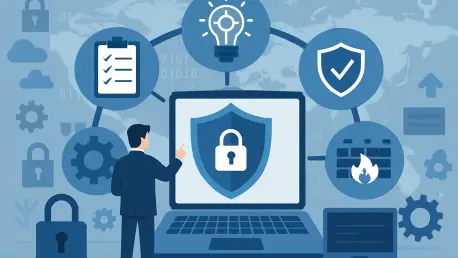In an era where cyber breaches can erase billions in market value overnight, the role of the Chief Information Security Officer (CISO) has become a linchpin for organizational survival and growth. A staggering statistic sets the stage: the average cost of a data breach now hovers at $4.45 million globally, underscoring the financial stakes tied to cybersecurity. This market analysis dives into how CISOs are no longer just technical gatekeepers but strategic architects, bridging the gap between security imperatives and business objectives. It examines current trends, data-driven insights, and future projections to illuminate the expanding influence of CISOs across industries. The purpose is to provide a clear understanding of their evolving role in shaping competitive advantage, ensuring regulatory compliance, and driving innovation amidst a rapidly shifting digital landscape.
Deep Dive into Market Dynamics and CISO Impact
Current Trends: The Strategic Shift in CISO Responsibilities
The cybersecurity market is witnessing a profound transformation in the CISO role, driven by escalating threats and digital expansion. Once confined to managing IT defenses, CISOs now oversee complex ecosystems that include cloud infrastructures, remote work environments, and third-party partnerships. This shift is reflected in market data showing a growing number of CISOs reporting directly to CEOs or boards, with a notable 30% increase in such structures over recent years. This elevation signals a broader recognition of cybersecurity as a core business function, critical to maintaining customer trust and operational continuity across sectors like finance, healthcare, and retail.
Beyond hierarchical changes, CISOs are increasingly tasked with translating cyber risks into business metrics that resonate with executive leadership. This trend is fueled by the need to justify security investments in a language of revenue impact and market positioning. For instance, in industries like e-commerce, a single breach during peak sales seasons can disrupt millions in transactions, pushing CISOs to align security protocols with business cycles. The market response has been a surge in demand for CISOs with hybrid skills—technical expertise paired with strategic acumen—highlighting a talent gap that companies are racing to address.
Data Insights: Investment and Resource Challenges
Analyzing market data reveals a mixed picture of investment in cybersecurity leadership. While budgets for security have seen incremental growth, often averaging around 10% annually, many organizations still grapple with resource constraints. This limited funding often hampers the ability of CISOs to implement comprehensive strategies, particularly in small to medium-sized enterprises where cybersecurity competes with other operational priorities. Reports indicate that nearly half of these firms lack dedicated security leadership, relying instead on shared IT roles, which dilutes focus and effectiveness.
The talent shortage further compounds these challenges, with the cybersecurity workforce gap projected to widen through at least 2027. This scarcity drives up costs for hiring skilled professionals and increases reliance on automation tools to bridge operational gaps. Market analysis shows a booming segment for AI-driven security solutions, with adoption rates climbing as companies seek to enhance threat detection without expanding headcount. For CISOs, this means navigating a delicate balance between leveraging technology and advocating for human capital investments to build resilient teams.
Future Projections: Technological and Regulatory Horizons
Looking toward the horizon, several projections shape the market outlook for CISOs and cybersecurity integration. Artificial Intelligence (AI) is poised to become a standard tool, not just for operational efficiency but as a strategic asset in predictive threat modeling. Market forecasts suggest that by 2027, over 70% of enterprises will embed AI into their security frameworks, freeing CISOs to focus on broader business alignment. However, emerging technologies like quantum computing introduce risks to current encryption standards, prompting early investments in post-quantum cryptography across tech-heavy industries.
Regulatory pressures are also set to intensify, with frameworks like the EU’s NIS2 directive and U.S. SEC disclosure rules expanding accountability for CISOs. Market trends indicate a growing need for compliance expertise, as non-compliance penalties can cripple financial standings, especially in regulated sectors like banking and healthcare. Projections show an uptick in demand for Directors and Officers (D&O) liability insurance as personal liability risks rise, reflecting a market shift toward protecting individual executives amid legal scrutiny. These dynamics suggest that CISOs will need to deepen their strategic involvement in corporate governance to navigate this complex landscape.
Sectoral Impacts: Variations Across Industries
The influence of CISOs varies significantly across market sectors, driven by unique risk profiles and operational needs. In financial services, where data breaches can trigger immediate regulatory and customer backlash, CISOs are often embedded in executive decision-making, shaping policies around digital transactions and fraud prevention. Market analysis highlights robust investment in real-time monitoring tools within this sector, with spending outpacing other industries by nearly 20%.
In contrast, in manufacturing, the focus for CISOs often centers on securing operational technologies and supply chain networks, areas increasingly targeted by ransomware. Here, the market shows slower adoption of strategic CISO roles, with many firms still viewing security as an IT function rather than a business driver. This lag creates vulnerabilities that competitors in more digitally mature sectors can exploit. Meanwhile, healthcare faces a dual challenge of protecting patient data under strict regulations like HIPAA and enabling telehealth innovations, positioning CISOs as key players in balancing compliance with growth—a dynamic mirrored in rising market demand for specialized security solutions tailored to medical environments.
Reflections and Strategic Pathways Forward
This market analysis uncovers critical insights into how CISOs have transformed into indispensable strategic leaders, a shift cemented by escalating cyber risks, technological advancements, and regulatory demands. The examination of trends and data paints a landscape where cybersecurity has moved from a peripheral concern to a central pillar of business strategy. Key implications emerge, such as the persistent resource constraints that challenge many organizations and the looming talent shortage that threatens long-term resilience.
Looking back, the journey underscores the necessity for industries to prioritize CISOs as partners in innovation rather than mere defenders of systems. As a forward-looking step, organizations should commit to integrating CISOs into strategic planning from the outset, ensuring security shapes market expansions and product rollouts. Another actionable pathway is to accelerate investments in automation to offset workforce gaps while fostering a security-first culture through comprehensive employee training. Ultimately, the lesson is clear: treating cybersecurity as a competitive advantage can position companies to turn vulnerabilities into trust-building opportunities, securing their place in a digital-first economy.









